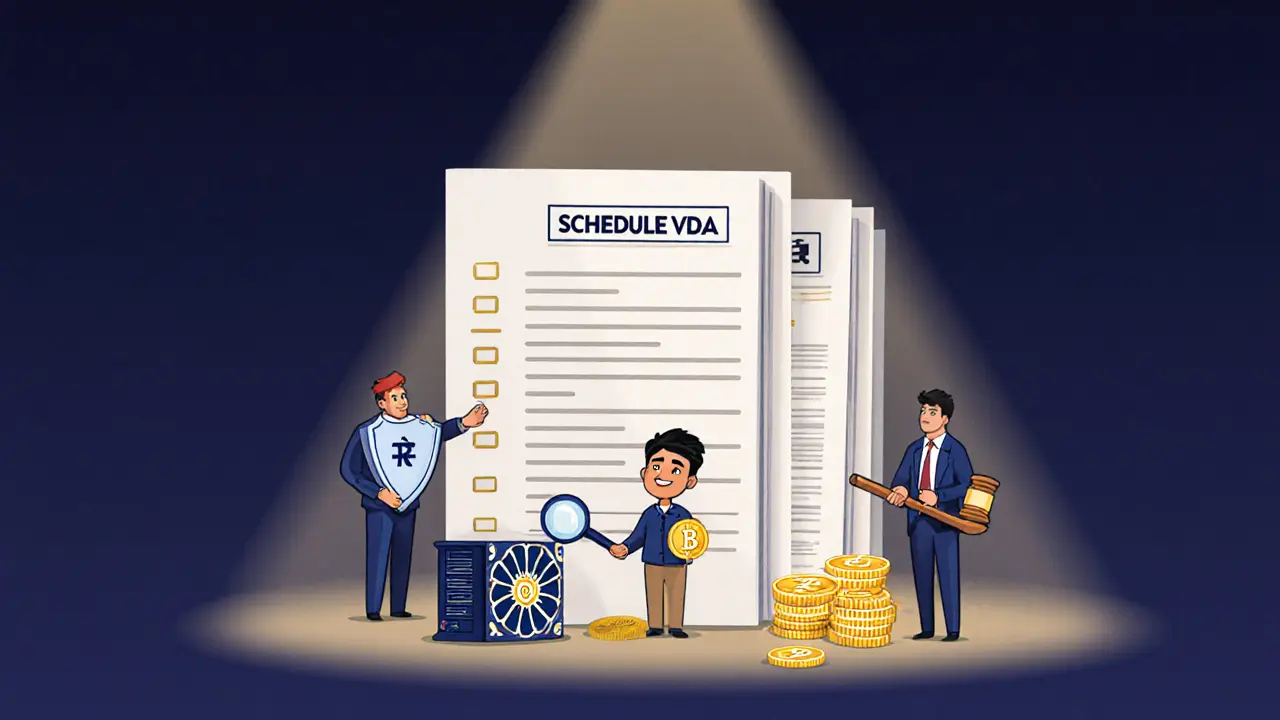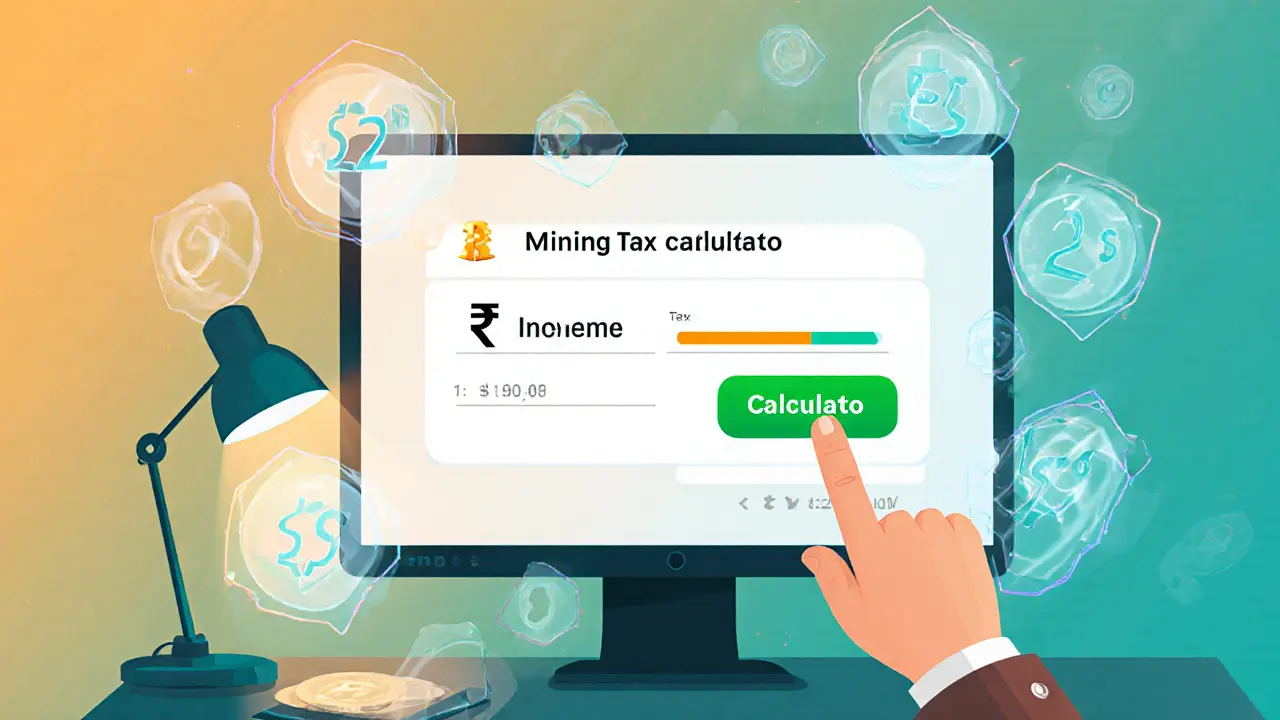Crypto Mining Tax Calculator
Mining Income Input
Enter your monthly mining income in Indian Rupees (₹) to calculate the tax burden.
Tax Breakdown
Enter your income and click "Calculate Tax Burden" to see the breakdown.
Important Notes
- This calculator reflects the current Indian tax framework for crypto mining.
- It includes income tax, cess, TDS, and GST on exchange services.
- Operational costs (electricity, hardware, pool fees) are not deductible.
- Effective tax rate exceeds 49% based on current rules.
Anyone looking to set up crypto mining India quickly bumps into a maze of tax tables, AML notices and a handful of agencies that seem to watch every hash. The short answer: mining isn’t illegal, but the tax bite and compliance chores make the business a steep uphill climb.
Key Takeaways
- Mining is treated as a Virtual Digital Asset (VDA) activity, not a separate legal class.
- A flat 30% tax on mined income plus 4% cess, 1% TDS on every transaction and 18% GST on platform services push the effective tax rate above 49%.
- Operational costs (electricity, hardware, pool fees) cannot be deducted - only the purchase price of the crypto itself is allowed.
- Compliance involves the Income Tax Department, the Financial Intelligence Unit (FIU‑IND), the Reserve Bank of India (RBI) and the Securities and Exchange Board of India (SEBI).
- Future changes - adoption of the OECD CARF framework and a pending discussion paper - could tighten reporting or, conversely, add clarity.
Legal Framework Overview
The Indian government never enacted a law that outright bans cryptocurrency mining. Instead, mining falls under the broader Virtual Digital Asset (VDA) definition introduced in the 2022 VDA regulations and reaffirmed by the Income Tax (No.2) Bill, 2025. Section2(47A) of the Income Tax Act, 1961 now lists any token or code created through cryptography as a VDA, explicitly excluding fiat money.
Because mining isn’t singled out, it’s subject to the same compliance regime as any other VDA transaction. That means every miner must file ScheduleVDA in their Income Tax Return, disclose the date of reward, the token name, its fair market value in INR, and any TDS already paid.
Multiple agencies keep an eye on the activity. The Financial Intelligence Unit (FIU‑IND) enforces anti‑money‑laundering (AML) rules under the Prevention of Money Laundering Act, 2002. The Reserve Bank of India (RBI) issues periodic cautions about crypto risks, while Securities and Exchange Board of India (SEBI) started monitoring token‑like securities from April12025.
Taxation Rules That Bite
India’s tax regime is the heaviest in the world for crypto miners. The flat 30% income tax on VDA earnings applies whether you’re an individual or a partnership. On top of that, a 4% health & education cess is levied, raising the statutory rate to 31.2%.
Every crypto‑related transaction, including the conversion of mined coins to fiat, triggers a 1% Tax‑Deducted‑at‑Source (TDS) that the exchange must withhold and remit. Since July2025, major exchanges have been forced to charge an 18% Goods and Services Tax (GST) on all services - from wallet withdrawals to conversion fees.
Because the law permits no deductions for electricity, hardware depreciation, cooling costs or pool fees, the effective tax burden balloons. A simple calculator shows a miner earning ₹1,00,000 of net value per month faces:
| Component | Rate | Amount (₹) |
|---|---|---|
| Income Tax (30%) | 30% | 30,000 |
| Cess (4%) | 4% | 4,000 |
| TDS (1%) | 1% | 1,000 |
| GST on Exchange Services (18%) | 18% | 18,000 |
| Total Effective Tax | ~53% | 53,000 |
When you factor in the cost of hardware (which can’t be written off) and high electricity tariffs in many states, the margin shrinks dramatically.

Practical Compliance Checklist
- Register for a PAN and open a dedicated bank account for mining proceeds.
- Maintain a ledger that records: hardware serial numbers, purchase invoices, electricity bills, pool fees, and timestamps of each reward.
- File ScheduleVDA in your ITR before the July31 deadline, listing every mined token, its INR value on the day of receipt, and the TDS already deducted.
- Submit Form15CA/15CB for any foreign exchange conversion above ₹25,00,000, as required by the RBI’s foreign exchange rules.
- Ensure the exchange you use is FIU‑IND registered; otherwise you risk a fine or a frozen account.
- Keep copies of all notices issued by Project Insight (the AI‑driven tax monitoring system) and respond within 30days.
Enforcement Actions & Penalties
Recent enforcement shows the government isn’t shy about cracking down. In 2025, the FIU‑IND fined Binance INR18.82crore and Bybit INR9.27crore for AML violations. While those were exchanges, the same legal tools can target miners who fail to file ScheduleVDA or hide income.
Penalties for tax evasion range from 50% to 200% of the tax due, plus possible imprisonment for up to seven years. The AI‑based surveillance platforms - Project Insight, NMS and NUDGE - cross‑reference blockchain wallet addresses with bank statements, making anonymity difficult.
Economic Viability in the Indian Context
Because operational costs can’t be deducted, small‑scale miners often find the venture unprofitable. A 2024 study of home‑based miners in Karnataka showed an average break‑even hash rate of 2GH/s when electricity costs hit ₹10 per kWh - a figure many households can’t meet.
Commercial farms face additional hurdles: import duties on ASICs (up to 20% plus GST), state‑level power caps, and the looming possibility of a sector‑specific licensing rule, as hinted in the April2025 multi‑agency proposal.
That said, a few high‑efficiency farms in regions with surplus hydro power (e.g., Himachal Pradesh) are still marginally profitable, but they operate under strict reporting and are subject to periodic audits by the Income Tax Department.
Future Outlook & What to Watch
The Indian government plans to adopt the OECD Crypto‑Asset Reporting Framework (CARF) by April2027. CARF will require Indian residents to disclose offshore mining pools and cross‑border hash power, effectively extending India’s tax net worldwide.
In June2025 a discussion paper was released inviting comments on a comprehensive crypto‑regulatory law. The paper hints at three possible paths:
- A permissive framework that allows deduction of mining expenses and sets a lower corporate tax rate.
- A stricter regime that treats large‑scale mining as a financial service, bringing it under SEBI supervision.
- An outright ban on domestic mining, similar to the RBI’s 2018 stance on crypto trading (though that ban was overturned).
Until a clear rulebook lands, the safest approach is to keep operations transparent, use FIU‑IND‑registered exchanges, and maintain pristine records. That way, whether the future brings a liberal amendment or a tighter clamp, you’ll be ready.

Frequently Asked Questions
Is cryptocurrency mining illegal in India?
No. Mining is not expressly prohibited, but it is treated as a Virtual Digital Asset activity and subject to heavy tax and AML compliance.
What tax rate applies to mined crypto?
A flat 30% income tax plus 4% cess, 1% TDS on every transaction, and 18% GST on exchange services. The effective tax burden exceeds 49%.
Can I deduct electricity and hardware costs?
No. The law only allows deduction of the acquisition cost of the crypto itself. All operational expenses are non‑deductible.
Which agencies do I need to report to?
Primarily the Income Tax Department (via ScheduleVDA), the Financial Intelligence Unit (FIU‑IND) for AML, and you must use a FIU‑IND‑registered exchange as overseen by the RBI and SEBI.
What’s coming in the next two years?
India will likely adopt the OECD CARF framework by 2027 and may roll out a comprehensive crypto law after the 2025 public consultation, which could change tax rates, introduce licensing, or even restrict mining altogether.












People Comments
India’s crypto mining tax sits just under half of any earnings you pull from rigs and it’s baked into the income tax schedule.
The very notion of taxing computational alchemy invites a philosophical dance between liberty and stewardship, a kaleidoscope of fiscal ethos that colors our digital frontier.
Behold the grand tapestry of regulation, where every hash becomes a thread woven into the sovereign ledger of burden.
Mining in India feels like trying to sprint uphill with a sack of bricks on your back while the sun blazes overhead.
This tax regime is a dumpster fire for anyone trying to stay afloat in the crypto world.
The tax is insane.
When you tally the percentages, the effective rate climbs past the forty‑nine percent mark, which on paper looks daunting but also sparks a curious resilience in the community.
One might argue that such a heavy levy could dissuade newcomers, yet history shows that high barriers often breed ingenuity.
The very act of paying the tax becomes a catalyst for optimizing hardware, for hunting the cheapest electricity contracts, and for collaborating on shared mining pools.
Each miner, in response, becomes a micro‑engineer, constantly tweaking firmware and overclocking settings.
Meanwhile, the government claims the revenue fuels public projects, a claim that, while noble, remains opaque in its execution.
At the same time, the lack of deductions for operational costs feels like an oversight, ignoring the real expenses that chip away at margins.
Nevertheless, the conversation around crypto mining in India is gaining traction, bringing together technologists, economists, and policy wonks.
It is this interdisciplinary dialogue that may eventually shape a more balanced framework.
For now, miners are forced to juggle profit calculations with compliance headaches.
Some vendors are stepping in, offering tax‑friendly contracts, but these are still in their infancy.
The community is also turning to decentralized finance solutions to hedge against tax exposure.
In the grand scheme, the high tax rate may act as a filter, weeding out hobbyists and leaving only the serious operators.
Those who remain will likely drive the next wave of innovation in low‑power ASIC design.
In short, while the tax burden is steep, it also ignites a fire of adaptation and strategic thinking that could benefit the ecosystem in the long run.
Oh great, another reason to shut down the rigs and watch the profits melt like butter.
It’s almost comical how the tax code pretends to be a guardian of fairness while crushing the very innovators it claims to protect.
According to the current provisions, crypto‑mining incomes are subject to the slab‑based income tax, with an additional education cess of two percent; however, the phrasing in the official Gazette occasionally suffers from typographical oversights, which may lead to interpretational ambiguities.
Seriously, someone should write a drama about this tax – the tension, the betrayal, the epic showdown between miners and the revenue office.
Everyone’s singing the horrors of the tax, yet I’ll wager that a few clever operators will turn this into a profit‑making art form – the very thing critics love to dismiss.
It might help to share cost‑reduction tips and collaborate on efficient cooling solutions to mitigate the tax impact.
Stay positive, folks! 💪 With the right strategy you can still make mining worthwhile – keep sharing tips and vibes! 😊
Let me guess, you all think the tax is a death sentence, but the real issue is that many don’t understand the underlying hardware economics.
While the fiscal burden appears formidable, it is essential to approach the matter with a balanced perspective; thoughtful planning can alleviate many of the pressures. 😊
Of course, the tax is just a smokescreen – the real problem is that the whole crypto narrative is built on hype, not substance.
Yo, I’ve seen people run rigs in basements and still find a way to beat the tax by using renewable energy credits.
Building on @John’s earlier thought, it’s worth noting that community‑driven knowledge bases can demystify the tax filing process for newcomers.
The tax’s sting is real, but adaptations like off‑grid solar setups can slice those costs dramatically.